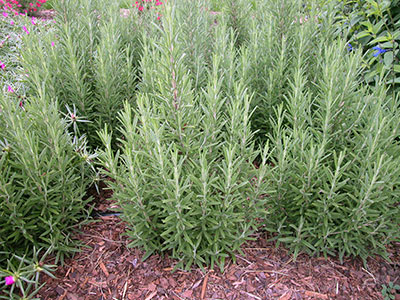Rosemary
Rosemary is a fragrant herb that can enhance both your cooking and your landscape.

Characteristics
Rosemary is a pungent, evergreen herb that’s great for cooking and very easy to grow. The narrow, needle-like leaves emit a sharp, somewhat pine-like aroma when crushed. You can use them fresh in meals or dry them for later use.
Rosemary is often used to season meats like pork, chicken, and lamb, but it’s equally delicious when used on roasted potatoes or in soups and rustic breads.
Rosemary is also an attractive, drought-tolerant plant that works well in containers and landscape beds. It blooms in winter and spring with small pink, lavender, or blue flowers, depending on the cultivar.
Rosemary typically grows as a woody perennial or small shrub and is known scientifically as Salvia rosmarinus. It can reach up to 6 feet tall and 4 to 5 feet wide when planted in the ground but will remain smaller if pruned or planted in containers. Groundcover forms of rosemary are also available, including the ‘Prostratus’ cultivar.
This Florida-Friendly plant will thrive in Florida year-round, although it may need to be protected from freezes in colder areas of the state.
Rosemary can also be trimmed into interesting topiary shapes. Around the holidays, many stores sell potted rosemary plants that have been shaped into Christmas tree shapes.
Planting and Care
It’s best to buy rosemary plants from a garden center, since it can be difficult to start rosemary plants from seed or cuttings.
Rosemary demands a well-drained soil and at least six hours of sun. The plant is originally from the Mediterranean, so it prefers dry conditions and suffers when watered too frequently.
For more information on rosemary, contact your county Extension office.
Also on Gardening Solutions
- Culinary Herbs to Plant This Fall
- Fragrance Gardens
- Herbs
- Holiday Gift Plants
- Mediterranean Gardens
- Rosemary Topiaries
- Super Drought-tolerant Plants
